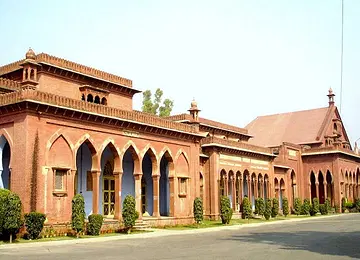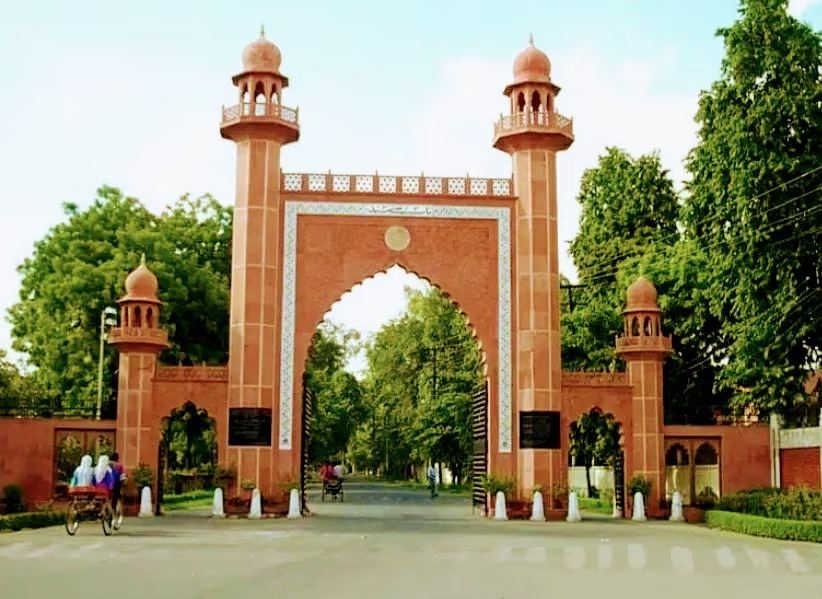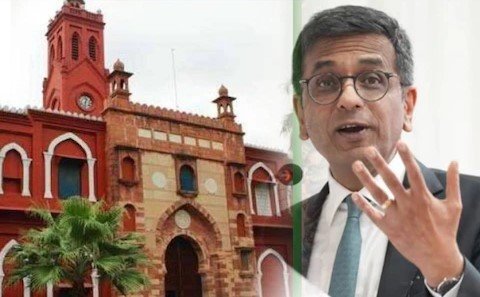Aligarh Muslim University Minority status: The Supreme Court has maintained the minority status of Aligarh Muslim University for now. However, another bench will hear this case. It is worth noting that the Supreme Court has not yet decided whether AMU is a minority institution or not. The Supreme Court has given its verdict on the minority status of Aligarh Muslim University (AMU). In this case, the decision has come from the Constitution Bench with a majority of 4:3. The 7-member Constitution Bench headed by Chief Justice of India (CJI) D.Y. Chandrachud had to decide whether the university’s minority institution status will remain or not. Earlier, the Constitution Bench headed by CJI Chandrachud had reserved the decision in this case. Apart from the CJI, this bench includes Justice Sanjeev Khanna, Suryakant, J.B. Pardiwala, Dipankar Dutta, Manoj Mishra and SC Sharma.
The Supreme Court has not yet decided whether AMU is a minority institution or not. Another the bench of 3 judges will decide on the status of AMU later.
Table of Contents
A religious community can establish an institution, but cannot run it
Delivering the verdict, the CJI said that a religious community can establish an institution but cannot run it. The CJI said that Article 30 would be weakened if it applies only to institutions that were established after the Constitution came into force. Thus educational institutions established by minorities that were established before the Constitution came into force would also be governed by Article 30. The distinction between the pre- and post-Constitution intention cannot be used to weaken Article 30(1).
CJI read in Aziz language that the establishment and administration of a minority institution are both together,
this court has said that the right under Article 30 is not absolute. CJI DY Chandrachud said what are the criteria for an institution to be considered a minority under Article 30A?
- Any educational institution established by any citizen can be regulated under Article 19(6).
- This court has said that the right under Article 30 is not absolute
- Regulation of minority educational institutions is permitted under Article 19(6), provided it does not violate the minority character of the institution.
CJI asked this question in this case
CJI said that SG has said that the Centre is not insisting on the preliminary objection that reference cannot be made to seven judges. It cannot be disputed that Article 30 guarantees non-discrimination against minorities. The question is whether there is any special right along with the right to non-discrimination.
In this case, the CJI’s question was what are the signs of considering an educational institution as a minority educational institution? Will an institution be considered a minority educational institution because it has been established by a person belonging to a religious or linguistic minority. Or is it being administered by a person belonging to a religious or linguistic minority?
What did the High Court say in its decision
The Constitution Bench of the Supreme Court was hearing a 2006 decision of the Allahabad High Court. The High Court order said that AMU is not a minority institution. In the year 2019, a three-judge bench of the Supreme Court handed over the matter to a seven-judge bench.
The seven-judge Constitution Bench heard the petitions filed regarding granting minority status to Aligarh Muslim University under Article 30 of the Constitution of India and later reserved the decision. The court heard the case for eight days.
What is the impact of AMU’s minority status on Jamia?
In the 1968 case of S. Aziz Basha vs Union of India, the Supreme Court had considered AMU as a central university, but in 1981, the minority status of the institute was restored by amending the AMU Act 1920. Later it was challenged in the Allahabad High Court and the matter reached the Supreme Court.
The effect of this decision will be that if the Supreme Court believes that Aligarh Muslim University will no longer have minority status, then SC/ST and OBC quota will be applicable in it too. Also, it will affect Jamia Millia Islamia.

When and who built Aligarh Muslim University?
- Sir Syed Ahmed Khan was born in 1817 in the Saadat (Syed) family of Delhi. At the age of 24, Syed Ahmed became a sub-judge in Mainpuri. It was at this time that he felt the need for a separate educational institution for the Muslim community.
- Before starting Aligarh Muslim University, Sir Syed Ahmed Khan formed the Muhammadan Anglo Oriental College Fund Committee in May 1872. This committee started the Muhammadan Anglo Oriental College in 1877.
- Meanwhile, the demand for a Muslim University in Aligarh intensified. After which the Muslim University Association was established. In 1920, with the help of the British government, the committee established this university by making the Aligarh Muslim University Act.
- After the formation of Aligarh Muslim University, all the committees formed earlier were dissolved and a new committee was formed in the name of Aligarh Muslim University. All rights and property were handed over to this committee.
- ABVP and other right wing organisations say that Raja Mahendra Pratap Singh donated 3.04 acres of land in 1929 for the establishment of this university. In such a situation, the founder of this university is not only Sir Ahmed Khan but also Hindu Raja Mahendra Pratap Singh.
Controversies Over Aligarh Muslim University’s Minority Status Began Post-Independence: Key Events in Timeline

Year 1951: Doors opened for non-Muslims too
Sections 8 and 9 of the AMU Act 1920 were abolished. Under this, compulsory religious education for Muslim students was abolished. Along with this, the doors of the university were opened for entry of people of any caste, gender, religion.
1965: Taken under the government
Section 23 of the AMU Act 1920 was amended under the government. Through this, the supreme power of the University Court was reduced and a body was formed for it like other universities. The university was then taken under the Ministry of Human Resource Development.
Year 1967: Supreme Court takes away minority status
In 1967, the case of minority status of Aligarh Muslim University came before a bench of 5 judges of the Supreme Court. The university administration argued that Sir Syed Ahmed Khan had formed a committee to establish this university. That committee raised funds by collecting donations to build it. The university was started for the benefit of minorities through the efforts of a minority. Therefore, it should get minority status.
The Supreme Court said in its decision that Sir Ahmed Khan and his committee went to the British government. The government made a law and recognized this university and started it. This is the reason that this university was neither built nor run by Muslims. This university was established by the Government of India at that time. Therefore, Aligarh Muslim University cannot be given minority status.
1981: Centre amends Act to grant minority status
Thirteen years after the Supreme Court verdict, in 1981, the Centre amended Section 2(1) of the AMU Act, restoring the university’s minority status by declaring it an institution favoured by Muslims.
It has been explained in the law that before Aligarh Muslim University, Muhammadan Anglo Oriental College was started. Later, the committee running it prepared the plan to start Aligarh University. This committee was headed by Sir Ahmed Khan. He was a minority, so this university should get minority status.
Also, Section 5(2)(c) of the Act added that this university is advancing the educational and cultural development of minority Muslims in India. Therefore, the basis for getting the status of a minority university is strong.
Year 2006: Allahabad High Court overturned the decision of the Government of India
It was the year 2005. This matter reached the court. This time the students of Aligarh University knocked the door of the High Court. These students had two demands.
First , the university should stop giving 75% reservation to Muslim students under minority status. In fact, Aligarh Muslim University had reserved 75% seats for Muslims for admission in its medical college. Whereas only 25% seats were kept for the general category.
Secondly , the university used to conduct the admission test for Muslim students, while AIIMS used to conduct the admission test for 25% seats reserved for the general category. This is the reason why students accused the university of discrimination in the university admission test as well.
In 2006, the Allahabad High Court declared the 1981 constitutional amendment made by the Central Government regarding Aligarh Muslim University as invalid. The High Court said that by amending the law, the Central Government has tried to wrongly change the judicial decision of the Supreme Court.
Aligarh Muslim University still does not have the status of a minority institution since the Allahabad High Court’s decision in 2006.
Several petitions were filed in the Supreme Court against this decision of the Allahabad High Court and demanded a review of the High Court’s decision. In 2016, the Central Government withdrew the petition. The Center argued that this is against the reservation for SC/ST/OBC/EWS implemented in the university.
Also read:

